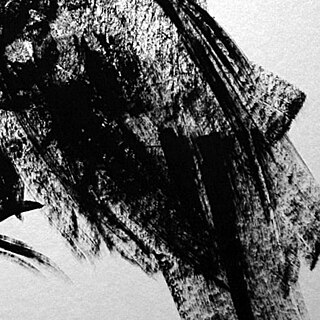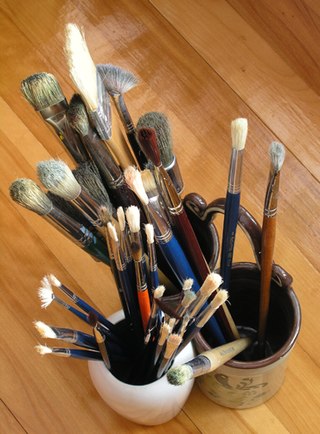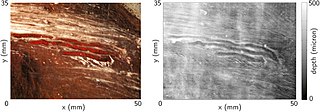
Acrylic paint is a fast-drying paint made of pigment suspended in acrylic polymer emulsion and plasticizers, silicone oils, defoamers, stabilizers, or metal soaps. Most acrylic paints are water-based, but become water-resistant when dry. Depending on how much the paint is diluted with water, or modified with acrylic gels, mediums, or pastes, the finished acrylic painting can resemble a watercolor, a gouache, or an oil painting, or it may have its own unique characteristics not attainable with other media.

Oil painting is a painting method involving the procedure of painting with pigments with a medium of drying oil as the binder. It has been the most common technique for artistic painting on canvas, wood panel or copper for several centuries, spreading from Europe to the rest of the world. The advantages of oil for painting images include "greater flexibility, richer and denser color, the use of layers, and a wider range from light to dark". But the process is slower, especially when one layer of paint needs to be allowed to dry before another is applied.

Gesso, also known as "glue gesso" or "Italian gesso", is a white paint mixture used to coat rigid surfaces such as wooden painting panels or masonite as a permanent absorbent primer substrate for painting. It consists of a binder mixed with chalk, gypsum, pigment, or any combination of these.

Gouache, body color, or opaque watercolor is a water-medium paint consisting of natural pigment, water, a binding agent, and sometimes additional inert material. Gouache is designed to be opaque. Gouache has a long history, having been used for at least twelve centuries. It is used most consistently by commercial artists for posters, illustrations, comics, and other design work.

Canvas is an extremely durable plain-woven fabric used for making sails, tents, marquees, backpacks, shelters, as a support for oil painting and for other items for which sturdiness is required, as well as in such fashion objects as handbags, electronic device cases, and shoes. It is popularly used by artists as a painting surface, typically stretched across a wooden frame.

Watercolor or watercolour, also aquarelle, is a painting method in which the paints are made of pigments suspended in a water-based solution. Watercolor refers to both the medium and the resulting artwork. Aquarelles painted with water-soluble colored ink instead of modern water colors are called aquarellum atramento by experts. However, this term has now tended to pass out of use.

Hermann Mejía is a Venezuelan–American painter and sculptor known for his work for Mad magazine. He was named by HuffPost as "one of 15 famous Venezuelan artists to know".

Blick Art Materials is a family-owned retailer and catalog art supply business. Established as a mail order business by Dick Blick in 1911 and purchased by Robert Metzenberg in 1947, it is one of the oldest and largest art materials suppliers in the United States, as well as a primary supplier of mail order art supplies.

Drybrush is a painting technique in which a paint brush that is relatively dry, but still holds paint, is used to create a drawing or painting. Load is applied to a dry support such as paper or primed canvas. The resulting brush-strokes have a characteristic scratchy and textured look that lacks the smooth appearance that washes or blended paint commonly have. This technique can be used to achieve a blurred or soft appearance.
Grumbacher is a US brand of art materials. Grumbacher offers products for artists including acrylic paints, oil paints, watercolor paints and other painting media, as well as brushes.

A wash is a term for a visual arts technique resulting in a semi-transparent layer of colour. A wash of diluted ink or watercolor paint applied in combination with drawing is called pen and wash, wash drawing, or ink and wash. Normally only one or two colours of wash are used; if more colours are used the result is likely to be classified as a full watercolor painting.
Acrylic painting techniques are different styles of manipulating and working with polymer-based acrylic paints. Acrylics differ from oil paints in that they have shorter drying times and are soluble in water. Since this type of paint dries quickly you will need to work somewhat quickly if you do not want your paint to dry out. There are benefits to adding water before it dries out completely because you can reactivate the paint. These types of paint eliminate the need for turpentine and gesso, and can be applied directly onto canvas. Although they do not need gesso it can be beneficial to give your canvas a few coats of gesso to improve the life of the painting and have a smoother surface to work with. Having various paint brushes and a multi color palette is helpful in finding a technique that works for you. Aside from painting with concentrated color paints, acrylics can also be watered down to a consistency that can be poured or used for glazes.

Painting is a visual art, which is characterized by the practice of applying paint, pigment, color or other medium to a solid surface. The medium is commonly applied to the base with a brush, but other implements, such as knives, sponges, and airbrushes, may be used. One who produces paintings is called a painter.

Daler-Rowney Ltd is an English art materials manufacturer based in Bracknell. The company, a subsidiary of conglomerate F.I.L.A. Group, manufactures and commercialises a wide range of artist products such as Acrylic, oil, watercolor, brushes, charcoal, pastel, color pencils, and papers.

Royal Talens is a Dutch company located in Apeldoorn that specializes in art materials. The company produces and markets its own products, apart from commercializing other licensed brands, such as Van Gogh, Rembrandt, and Bruynzeel. Products commercialised include acrylic paints, oil paints, watercolor paintings, brushes, markers, inks, pastels, pencils, pens, gouache, canvas, papers.

A paintbrush is a brush used to apply paint or ink. A paintbrush is usually made by clamping bristles to a handle with a ferrule. They are available in various sizes, shapes, and materials. Thicker ones are used for filling in, and thinner ones are used for details. They may be subdivided into decorators' brushes used for painting and decorating and artists' brushes use for visual art.

The conservation and restoration of paintings is carried out by professional painting conservators. Paintings cover a wide range of various mediums, materials, and their supports. Painting types include fine art to decorative and functional objects spanning from acrylics, frescoes, and oil paint on various surfaces, egg tempera on panels and canvas, lacquer painting, water color and more. Knowing the materials of any given painting and its support allows for the proper restoration and conservation practices. All components of a painting will react to its environment differently, and impact the artwork as a whole. These material components along with collections care will determine the longevity of a painting. The first steps to conservation and restoration is preventive conservation followed by active restoration with the artist's intent in mind.
Jerry's Artarama is an originator of discount art supplies and materials company currently based in North Carolina, United States. The art materials it provides include fine artist paints, canvas and boards, brushes and palette knives, easels, frames as well as extensive custom canvas and frame departments.

In visual arts, the ground is a prepared surface that covers the support of the picture and underlies the actual painting. Occasionally the term is also used in a broad sense to designate any surface used for painting, for example, paper for watercolor or plaster for fresco.















